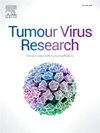The immunological heterogeneity of squamous cell carcinoma and adenocarcinoma of the uterine cervix: a systematic review
IF 8.1
Q1 VIROLOGY
引用次数: 0
Abstract
Background
Cervical cancer is the fourth most common malignancy in women worldwide and generally driven by persistent infection with high-risk human papillomavirus. Squamous cell carcinoma (SCC) and adenocarcinoma (AC) are the two most common histological subtypes, with a relative increase in adenocarcinomas in the last decades. The immunological differences between cervical squamous cell carcinoma and adenocarcinoma remain largely unexplored. Understanding these distinctions is crucial for developing tailored therapies that can improve treatment outcomes for patients with cervical cancer. This systematic review provides an overview of the immunological features of squamous cell carcinoma and adenocarcinoma of the uterine cervix.
Methods
A systematic search was performed in PubMed, Embase.com, Web of Science, and Cochrane Library. All articles addressing immunological features of squamous cell carcinoma and adenocarcinoma of the uterine cervix were reviewed and included based on predefined inclusion and exclusion criteria.
Results
In total, 3207 articles were screened, of which 43 were included. Studies show that cervical squamous cell carcinomas are characterised by a more inflamed tumour microenvironment, but also contain more regulatory T cells and immune checkpoints. In contrast, adenocarcinomas are characterised by lower immune cell infiltration, contributing to its poorer prognosis and more limited response to treatment.
Conclusion
The observed differences emphasize the need for further research into subtype-specific differences and distinct therapeutic strategies. For squamous cell carcinomas, future research should focus on combinatorial immune checkpoint blockade, including regulatory T cell-depleting strategies. For adenocarcinomas, oncolytic virotherapy, therapeutic vaccination, and oncogenic signalling interference should be explored.
宫颈鳞状细胞癌和腺癌的免疫学异质性:系统综述
宫颈癌是世界范围内女性第四大常见恶性肿瘤,通常由高危人乳头瘤病毒持续感染引起。鳞状细胞癌(SCC)和腺癌(AC)是两种最常见的组织学亚型,在过去的几十年里腺癌的发病率相对增加。宫颈鳞状细胞癌和腺癌之间的免疫学差异在很大程度上仍未被研究。了解这些区别对于开发量身定制的治疗方法至关重要,可以改善宫颈癌患者的治疗效果。本文系统综述了宫颈鳞状细胞癌和腺癌的免疫学特征。方法系统检索PubMed、Embase.com、Web of Science、Cochrane Library。所有涉及宫颈鳞状细胞癌和腺癌的免疫学特征的文章都进行了审查,并根据预先确定的纳入和排除标准纳入。结果共筛选文献3207篇,纳入文献43篇。研究表明,宫颈鳞状细胞癌的特点是肿瘤微环境更炎症,但也含有更多的调节性T细胞和免疫检查点。相比之下,腺癌的特点是免疫细胞浸润较低,导致其预后较差,对治疗的反应较有限。结论观察到的差异强调需要进一步研究亚型特异性差异和明确的治疗策略。对于鳞状细胞癌,未来的研究应侧重于组合免疫检查点阻断,包括调节性T细胞消耗策略。对于腺癌,应探讨溶瘤病毒治疗、治疗性疫苗接种和致癌信号干扰。
本文章由计算机程序翻译,如有差异,请以英文原文为准。
求助全文
约1分钟内获得全文
求助全文
来源期刊

Tumour Virus Research
Medicine-Infectious Diseases
CiteScore
6.50
自引率
2.30%
发文量
16
审稿时长
56 days
 求助内容:
求助内容: 应助结果提醒方式:
应助结果提醒方式:


